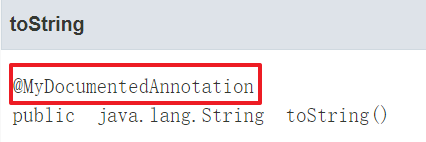-
java元注解
java元注解
本文涉及以下这些内容,如果不清楚的话,可以看一下,相信会对你有些许帮助。:
1)使用IntelliJ IDEA 2018查看字节码。
2)使用IntelliJ IDEA 2018生成帮助文档本文主要针对于java8,java8定义了6个标准元注解:@Target,@Retention,@Documented,@Inherited,@Repeatable和@Native。
1.@Target注解。
@Target注解的作用是:描述注解的使用范围(即被修饰的注解可以用在什么地方)。@Target注解用来说明那些被他注解的注解类可修饰的对象范围。@Target注解源码:
@Documented @Retention(RetentionPolicy.RUNTIME) @Target(ElementType.ANNOTATION_TYPE) public @interface Target { ElementType[] value(); }- 1
- 2
- 3
- 4
- 5
- 6
- 7
- 8
@Target注解的枚举参数:
public enum ElementType { //类,接口,枚举类 TYPE, //成员变量,枚举常量 FIELD, //方法 METHOD, //形式参数 PARAMETER, //构造方法 CONSTRUCTOR, //局部变量 LOCAL_VARIABLE, //注解 ANNOTATION_TYPE, //包 PACKAGE, //类型参数 TYPE_PARAMETER, //类型使用 TYPE_USE }- 1
- 2
- 3
- 4
- 5
- 6
- 7
- 8
- 9
- 10
- 11
- 12
- 13
- 14
- 15
- 16
- 17
- 18
- 19
- 20
- 21
- 22
- 23
- 24
- 25
- 26
- 27
- 28
- 29
- 30
- 31
- 32
2.@Retention注解。
@Retention注解的作用是:描述注解保留的时间范围(即:被描述的注解在它所修饰的类中可以被保留到何时)。@Retention注解用来限定那些被他所注解的注解类在注解到其他类上以后,可被保留到何时。@Retention注解源码:
@Documented @Retention(RetentionPolicy.RUNTIME) @Target(ElementType.ANNOTATION_TYPE) public @interface Retention { RetentionPolicy value(); }- 1
- 2
- 3
- 4
- 5
- 6
- 7
- 8
@Retention注解的枚举参数:
public enum RetentionPolicy { //源文件保留 SOURCE, //编译期保留,默认值 CLASS, //运行期保留,可通过反射去获取注解信息 RUNTIME }- 1
- 2
- 3
- 4
- 5
- 6
- 7
- 8
- 9
- 10
- 11
- 12
下面我们举个例子:
注解:
@Retention(RetentionPolicy.SOURCE) public @interface SourcePolicy { }- 1
- 2
- 3
注解:
@Retention(RetentionPolicy.CLASS) public @interface ClassPolicy { }- 1
- 2
- 3
注解:
@Retention(RetentionPolicy.RUNTIME) public @interface RuntimePolicy { }- 1
- 2
- 3
测试类:
public class RetentionTest { @SourcePolicy public void sourcePolicy(){ } @ClassPolicy public void classPolicy(){ } @RuntimePolicy public void runtimePolicy(){ } }- 1
- 2
- 3
- 4
- 5
- 6
- 7
- 8
- 9
- 10
- 11
- 12
- 13
- 14
- 15
- 16
- 17
- 18
RetentionPolicy 类的字节码文件中三个方法的部分:
public void sourcePolicy(); descriptor: ()V flags: ACC_PUBLIC Code: stack=0, locals=1, args_size=1 0: return LineNumberTable: line 8: 0 LocalVariableTable: Start Length Slot Name Signature 0 1 0 this Lannotation/RetentionTest; public void classPolicy(); descriptor: ()V flags: ACC_PUBLIC Code: stack=0, locals=1, args_size=1 0: return LineNumberTable: line 13: 0 LocalVariableTable: Start Length Slot Name Signature 0 1 0 this Lannotation/RetentionTest; RuntimeInvisibleAnnotations: 0: #14() public void runtimePolicy(); descriptor: ()V flags: ACC_PUBLIC Code: stack=0, locals=1, args_size=1 0: return LineNumberTable: line 18: 0 LocalVariableTable: Start Length Slot Name Signature 0 1 0 this Lannotation/RetentionTest; RuntimeVisibleAnnotations: 0: #17()- 1
- 2
- 3
- 4
- 5
- 6
- 7
- 8
- 9
- 10
- 11
- 12
- 13
- 14
- 15
- 16
- 17
- 18
- 19
- 20
- 21
- 22
- 23
- 24
- 25
- 26
- 27
- 28
- 29
- 30
- 31
- 32
- 33
- 34
- 35
- 36
- 37
- 38
- 39
- 40
根据上面方法的字节码我们可以看出:
1)编译器没有记录sourcePolicy方法的注解信息。
2)编译器使用了RuntimeInvisibleAnnotations属性记录classPolicy方法的注解信息,使用RuntimeVisibleAnnotations属性记录runtimePolicy方法的注解信息。3.Documented注解。
Documented注解的作用是:描述在使用javadoc工具为类生成帮助文档时是否要保留其注解信息。Documented注解源码:
@Documented @Retention(RetentionPolicy.RUNTIME) @Target(ElementType.ANNOTATION_TYPE) public @interface Documented { }- 1
- 2
- 3
- 4
- 5
下面我们举个例子:
注解:
@Documented @Target({ElementType.TYPE,ElementType.METHOD}) public @interface MyDocumentedAnnotation { }- 1
- 2
- 3
- 4
- 5
测试类:
@MyDocumentedAnnotation public class MyDocumentedTest { @MyDocumentedAnnotation @Override public String toString(){ return this.toString(); } }- 1
- 2
- 3
- 4
- 5
- 6
- 7
- 8
- 9
- 10
查看生成的帮助文档:


接下来把@Documented注解去掉,重新生成帮助文档:


由此我们可以看出@Documented注解的作用。
4.Inherited注解。
Inherited注解的作用是:使被他修饰的注解具有继承性(如果某个类使用了被@Inherited修饰的注解,则其子类将自动具有该注解。)下面我们举个例子:
注解:
@Inherited @Target(ElementType.TYPE) @Retention(RetentionPolicy.RUNTIME) public @interface MyInheritedAnnotation { public String name() default "pengjunlee"; }- 1
- 2
- 3
- 4
- 5
- 6
- 7
- 8
父类:
@MyInheritedAnnotation(name = "parent") public class Parent { }- 1
- 2
- 3
子类:
public class Child extends Parent { public static void main(String[] args) { Class<Child> child = Child.class; MyInheritedAnnotation annotation = child.getAnnotation(MyInheritedAnnotation.class); System.out.println(annotation.name()); } }- 1
- 2
- 3
- 4
- 5
- 6
- 7
- 8
- 9
输出:
parent5.@Repeatable注解。
@Repeatable注解的作用是:用于声明标记的注解为可重复类型注解,可以在同一个地方多次使用。@Repeatable 注解源码:
@Documented @Retention(RetentionPolicy.RUNTIME) @Target(ElementType.ANNOTATION_TYPE) public @interface Repeatable { Class<? extends Annotation> value(); }- 1
- 2
- 3
- 4
- 5
- 6
- 7
- 8
下面我们举个例子:
@Target(ElementType.TYPE) @Retention(RetentionPolicy.RUNTIME) public @interface MyRepeatableAnnotation { RepeatableAnnotationTest[] value(); }- 1
- 2
- 3
- 4
- 5
- 6
- 7
@Target(ElementType.TYPE) @Retention(RetentionPolicy.RUNTIME) @Repeatable(MyRepeatableAnnotation.class) public @interface RepeatableAnnotationTest { String key(); String value(); }- 1
- 2
- 3
- 4
- 5
- 6
- 7
- 8
- 9
- 10
@RepeatableAnnotationTest(key = "aa",value = "11") @RepeatableAnnotationTest(key = "bb",value = "22") public class RepeatableTest { public static void main(String[] args) { RepeatableAnnotationTest[] annotation = RepeatableTest.class.getAnnotation(MyRepeatableAnnotation.class).value(); for (RepeatableAnnotationTest a : annotation) { System.out.println(a); } } }- 1
- 2
- 3
- 4
- 5
- 6
- 7
- 8
- 9
- 10
- 11
- 12
输出:
@annotation.RepeatableAnnotationTest(key=aa, value=11)
@annotation.RepeatableAnnotationTest(key=bb, value=22)6.@Native注解。
@Native注解修饰成员变量,则表示这个变量可以被本地代码引用,常常被代码生成工具使用。对于@Native注解不常使用,了解即可。 -
相关阅读:
【C语言小例程26/100】
互联网相关概念——RFC
卷积神经网络-卷积层
单变量微积分重点(1)
[C++] Reference
Simulink-采样时间详解
Python 编程基础 | 第二章-基础语法 | 2.3、for 语句
c语言范例实例
Android 10.0 展讯lowmemorykiller低内存保活白名单,避免app在低内存被杀进程
数字验证学习笔记——SystemVerilog芯片验证10 ——类的成员
- 原文地址:https://blog.csdn.net/zh123456_789/article/details/115186313
